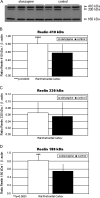The neurodevelopmental hypothesis of schizophrenia, revisited
- PMID: 19223657
- PMCID: PMC2669580
- DOI: 10.1093/schbul/sbn187
The neurodevelopmental hypothesis of schizophrenia, revisited
Abstract
While multiple theories have been put forth regarding the origin of schizophrenia, by far the vast majority of evidence points to the neurodevelopmental model in which developmental insults as early as late first or early second trimester lead to the activation of pathologic neural circuits during adolescence or young adulthood leading to the emergence of positive or negative symptoms. In this report, we examine the evidence from brain pathology (enlargement of the cerebroventricular system, changes in gray and white matters, and abnormal laminar organization), genetics (changes in the normal expression of proteins that are involved in early migration of neurons and glia, cell proliferation, axonal outgrowth, synaptogenesis, and apoptosis), environmental factors (increased frequency of obstetric complications and increased rates of schizophrenic births due to prenatal viral or bacterial infections), and gene-environmental interactions (a disproportionate number of schizophrenia candidate genes are regulated by hypoxia, microdeletions and microduplications, the overrepresentation of pathogen-related genes among schizophrenia candidate genes) in support of the neurodevelopmental model. We relate the neurodevelopmental model to a number of findings about schizophrenia. Finally, we also examine alternate explanations of the origin of schizophrenia including the neurodegenerative model.
Figures





References
-
- Rapoport JL, Addington AM, Frangou S, Psych MR. The neurodevelopmental model of schizophrenia: update 2005. Mol Psychiatry. 2005;10:434–449. - PubMed
-
- Fatemi SH. Prenatal viral infection, brain development and schizophrenia. In: Fatemi SH, editor. Neuropsychiatric Disorders and Infection. London, UK: Taylor and Francis; 2005.
-
- Krapelin E. Psychiatrie. 4th ed. Ein lehrbuch für studirende und ärzte [Psychiatry 4th Ed: A Textbook for Students and Physicians] Leipzeig, Germany: Abel; 1893.
-
- Brown AS, Begg MD, Gravenstein S, et al. Serologic evidence of prenatal influenza in the etiology of schizophrenia. Arch Gen Psychiatry. 2004;61:774–780. - PubMed
-
- Fatemi SH. Schizophrenia. In: Fatemi SH, Clayton PJ, editors. Medical Basis of Psychiatry. New York, NY: Humana Press; 2008. pp. 85–108.
Publication types
MeSH terms
Grants and funding
LinkOut - more resources
Full Text Sources
Other Literature Sources
Medical

